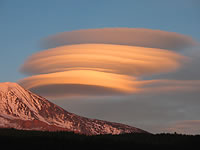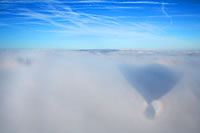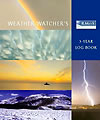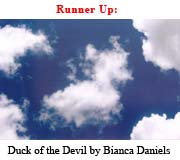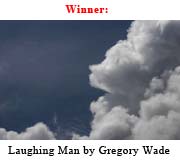If you were lucky enough to be off the coast of Mexico last month, you might have been treated to a spectacular optical effect known as a glory.
Category: Attention All Cloudspotters
You can’t look around when you’re looking up, so we’ve had a look around for you.
If you have cloud news that you think we should include here, please email it to us at: hello@cloudappreciationsociety.org.
Soon our skies may feature Mickey Mouse ears and Coca-Cola symbols, thanks to the latest bright idea in advertising.
Earthbound cloud watchers will be glad to know they are not alone.
China is preparing to fire rockets at any clouds threatening to rain on the Olympics opening ceremony.
Too much time on your hands? Looking for something to amuse the kids? Then why not try this game.
Fewer clouds may have led to super-greenhouse episodes
Cloud lovers will be proud to hear that our fluffy friends may soon be helping to slow down global warming.
As experienced spotters will know, low clouds can sometimes line up parallel to the wind to form cumulus radiatus, also known as cloud streets.
There is startling evidence that clouds are also home to a range of tiny organisms.
Is this a photograph of a UFO, or just a car park on a foggy night?
What do homemade smoke bombs and musical interludes have to do with clouds?
Two exhibitions in London museums featuring cloud content.
Never underestimate the power of clouds.
An unidentified flying cloud (UFC) has been spotted in Hungary.
Ever wondered what a journey through clouds might sound like?
New images of noctilucent clouds taken by a NASA spacecraft may help solve a few mysteries…
A seasonal cloud-lookalike has made the headlines in a New Zealand newspaper.
A beach on the Lincolnshire coast, will soon have its own official cloudspotting area…
Society founder gives Martha Stewart membership to the society…
Member’s photograph on the cover of the Weather Watcher’s 3-Year Log Book, published by the Royal Meteorological Society…
Most of us look up and marvel at clouds at least once a day – that is what makes us cloudspotters.
But chances are very few of us bother to keep a daily diary of what we have seen, unless we happen to be professional meteorologists.
Margaret Nelson (member 2812) is a keen amateur and records what she has seen near her Suffolk home in her online cloud journal. Her daily updates usually inlcude photographs, like the one shown here.
A striking picture taken by our photo gallery editor Ian Loxley features in a new book about extreme weather.
Storm Force, by TV weathermen Michael Fish, Ian McCaskill and Paul Hudson, was published last month to mark the twentieth anniversary of the October 1987 hurricane, which flattened much of south-eastern England.
It uses pictures and news reports from national and regional archives to recall the most amazing episodes of weather that have left trails of death and destruction across the UK.
The book includes Ian’s photograph of lightning, which has also featured on the front cover of the International Journal of Meteorology.
Society founder Gavin Pretor-Pinney will be giving a talk on cloudspotting on Monday, November 12 as part of the Bridport Literary Festival.
If you live in or near Dorset, then for the Eype Centre for the Arts at St Peter’s Church, where you will be able to hear Gavin extol the virtues of cloudspotting in person.
His illustrated talk starts at 2.30pm and you can download a copy of the festival brochure here.
If you click on the cloud photograph to the right and think perhaps it is time you wore glasses, you are right.
But your eyesight is probably fine – it is the picture that is playing tricks. It is an anaglyph image, which creates a stereoscopic 3D effect when viewed with two-colour glasses, usually cyan and red. Anaglyph images are made up of two colour layers, superimposed, but offset with respect to each other to produce a depth effect.
This example is part of a series of cloud pictures taken by Ben Orona. He says the two photographs which make up each 3D image were taken hundreds of feet apart, which helps give them their depth.
However, you will need a pair of anaglyph cyan-red glasses to see the 3D effect. You can buy them online – here, for example – but all the sites we found sold them in packs of five or ten. You may be able to buy them singly on eBay.
Amateur photographer Darlisa Black has written to tell us about a beautiful series of pictures she took of lenticular clouds near Mount Adams in the Pacific Northwest of the USA.
She was walking in the hills near her home in Washington State when she spotted the formation and spent nearly two hours capturing its changing shapes in the fading light.
“As with many volcanoes, certain weather conditions bring about lenticular
formations, and all my life I have witnessed many ‘caps’ on the nearby Mt.
Adams and Mt. Hood in Oregon.
“On November 6, I was fortunate to be up in the hills on my day off,
taking photos and enjoying the day. I could see a small lenticular formation near the mountain, so I decided to drive up 10 miles above Trout Lake, Washington, to a viewpoint I knew of with a great view of Mt. Adams.
‘I was so excited, and hiked along the edge of the cliff edged road for a mile, taking well over a hundred photos over the next hour and a half. Every time I started to quit and get in the truck, the colors and form would change again becoming even more amazing! I finally quit when all color was gone and it was getting dark.
“Every few minutes, the formation would change significantly. I loved it right at the end when it seemed the layers were lifting up away from the lowest layer, until there was a complete separation between the bottom two layers.”
The result is an absolutely stunning slideshow, which you can see here.
Society founder Gavin Pretor-Pinney features in a new film about the sky by one of our members, Esther Johnson.
Celestial takes the form of an experimental portrait, exploring the poetry of the sky, which is seen as a space of fascination and contemplation.
It features interviews with weather experts, scientists and cloud
lovers, focusing on their perceptions and thoughts about the sky. In the film, Gavin describes looking at clouds as a form of meteorological meditation.
Snippets of dialogue from the interviews are spliced with visuals, including time-lapse footage of the sky, cloud formations, aerial views and people cloudspotting. The film also uses sounds from weather monitoring equipment and noises created from the weather itself.
Celestial premiered a few weeks ago at the Urban Screens Conference in Manchester but there are a few more screenings coming up which members might like to try and attend: Urban Screens Conference Manchester, 02/11/07;
Aurora, Norwich, 10/11/07; 21st Leeds International Film Festival, 17-24/11/07; Site Gallery Sheffield, 03/08.
You can find out more about Celestial on Esther’s website, www.blanchepictures.com, and watch an extract of the film here: www.biggerpictureuk.net
Franz Ossing (member 9648) has drawn our attention to a lively debate in the art history world about whether the Dutch 17th-century masters painted realistic clouds.
There is no doubt the landscape artists of the Dutch “Golden Age”, like Jacob van Ruisdael, painted clouds beautifully. The question is whether the clouds in their paintings were meteorologically accurate.
Some art historians claim to be able to find the complete World Meteorological Organisation cloud atlas reproduced in landscapes from that period. Others argue that cloud forms were distorted to fit compositions and certain types of clouds that are typical for Holland did not appear in the paintings.
Anthea Howard (member 9169) is Membership Secretary of the Royal Meteorological Society and has sent us a copy of their Weather Watcher’s 3-Year Log Book.
Cloudspotters have more than a passing interest in the weather, so you may want to add this handsome book to your collection.
It is crammed with fascinating facts, including information on how to identify different cloud types and what weather they portend.
It gives explanations of weather forecasts and how to understand them and features stunning images of the weather in all its power and glory. You can even learn how to make simple weather measuring apparatus.
We get sent a lot of pictures of fierce clouds but Bruce Sharp (member 3979) has emailed us an impressive shot of the aftermath of a storm in Australia.
This is what was left of an ironbark eucalyptus, one of the hardest of timbers, after it was hit by lightning. Fence post-sized chunks were hurled up to 50 yards and the stump was lifted out of the ground.
The picture was taken by Col Coulson near Kingaroy in central Queensland.
 Have you ever wished you could watch clouds from the comfort of your own home, without even having to look out of the window?
Have you ever wished you could watch clouds from the comfort of your own home, without even having to look out of the window?
DVDs might be the answer, but American artist Georgie Friedman has come up with an intriguing, all-round experience.
Her Cloud Room is a four-channel, high-definition video installation with cloth walls, each with a cloud video on a loop. Find out more about it here.
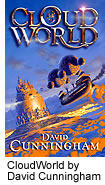 Scottish writer David Cunningham has written to tell us about his fantasy novel set on a planet divided by a permanent layer of clouds.
Scottish writer David Cunningham has written to tell us about his fantasy novel set on a planet divided by a permanent layer of clouds.
CloudWorld, an old-fashioned adventure story about a son’s search for his missing father, is aimed at young adult readers but might appeal to fans of Dune, with its citadels above the layer, ruling families, weird flying machines and fear of the world below.
You can find out more about it here: www.cloudworld.org
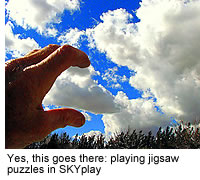 Seeing shapes in the sky and letting your imagination run riot is the fun side of cloudspotting.
Seeing shapes in the sky and letting your imagination run riot is the fun side of cloudspotting.
Our new book of cloud-lookalikes, A Pig with Six Legs and other Clouds, is proof that our members are not only extremely handy with cameras but also enjoy being playful.
So we think you might get a few laughs from SKYplay, a series of visual jokes using the sky and clouds as a backdrop.
Our thanks to Dave Hall for sending us the link.
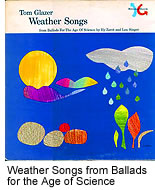 At last – something to listen to as you discuss the finer points of cloud formation with the rest of the family.
At last – something to listen to as you discuss the finer points of cloud formation with the rest of the family.
Our middle-aged American members may remember a series of educational children’s songs dating from the late 1950s called Ballads for the Age of Science by Lou Singer and Hy Zaret. Zaret is best known as the co-author of the 1955 hit Unchained Melody, one of the most recorded songs of the 20th century.
The six-album set included one of weather songs featuring such gems as How Clouds are Formed, Stratus and Cumulus, and Where is the Stratosphere? Here is a flavour of the lyrics, sung to a folksy guitar accompaniment:
“Clouds that are formed without any up and down movement – this information’s the latest,
“Cooled without rising and sheet-like or layered, sheet-like or layered, they’re stratus (pronounced stray-tus).”
The records were quite successful and the song Why Does the Sun Shine? (aka The Sun is a Mass of Incandescent Gas) was even covered by quirky alt-rockers They Might Be Giants in 1994.
An American called Jef Poskanzer has thoughtfully uploaded the songs as MP3 files onto his website and you can listen to them here. Our thanks to Jeff Waddell for telling us where to find them.
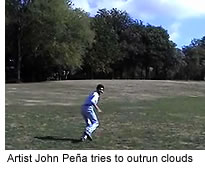 John Peña is an artist who likes to give clouds a run for their money.
John Peña is an artist who likes to give clouds a run for their money.
He has also been known to put clouds into small packages and send them all over the world.
John, who lives in Washington State in north-west USA, describes himself as a cloud artist. “Although my art is a bit less traditional, I am devoted to the glory of clouds.”
One of his projects was to try and outrun clouds, a futile exercise but fun to watch. You can see the video of this one-sided race here.
The idea to put a a cloud in the post was inspired by a walk in the hills near his home in Ellensburg. “I saw a cloud come so close to touching the ground that I was convinced it was going to get caught in the top of a tree and anchor itself. I thought how amazing it would be to run over and capture a part of that cloud and send it to a friend.
“This is exactly what I did and my friend greatly enjoyed it. I then thought how beautiful it would be to try and package an entire Ellensburg cloud and have the people of Ellensburg help me send it around the country and around the world.”
Find more about John’s cloud art on his website: www.johnpena.net
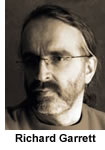 Avid readers may remember a recent piece about a Canadian professor who invented The Cloud Harp, an instrument that creates music from the shape of the clouds above it.
Avid readers may remember a recent piece about a Canadian professor who invented The Cloud Harp, an instrument that creates music from the shape of the clouds above it.
On a similar theme, English composer Richard Garrett has written to tell us how he makes music from the changing patterns of the weather as recorded by an electronic weather station.
You can hear some of the music and find out more about Richard’s Weathersongs project by visiting his website: www.weathersongs.org
 Astronomers are still struggling to understand a bizarre, six-sided cloud formation spotted circling Saturn’s north pole.
Astronomers are still struggling to understand a bizarre, six-sided cloud formation spotted circling Saturn’s north pole.
No one has seen anything like it anywhere else in the solar system. Unlike some of our individual clouds which look like a hexagon, the Saturn cloud pattern appears to have six well-defined sides of nearly equal length. Even stranger, it maintains its structure while rotating (see it spin). It is also huge: four Earths could fit inside it.
Originally discovered during NASA’s Voyager fly-bys in the 1980s, the recent infrared image taken by the Saturn-orbiting Cassini spacecraft, above, shows this cloud pattern is remarkably stable and may continue to baffle scientists for some time to come. Read more about it here.
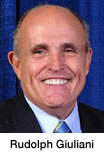 It is a cloud-crazy world out there.
It is a cloud-crazy world out there.
First we were horrified to read on the US satirical news website, The Onion, that Senator John Edwards was vowing to ban clouds. Imagine our relief to learn, therefore, that one of his presidential campaign opponents, Rudolph Giuliani, had rallied to their defence.
Now the website reports that scientists from the University of Chicago are theorising about what would happen if they touched a cloud. Read about it here.
Have you taken a photograph of a cloud that you are particularly proud of? Then you could win a digital camera.
Member Mark Humpage is running a competition to mark the launch of Cloud, a new natural-world photo agency, and has invited society members to take part.
 The theme of the competition is the natural world, which includes the weather, the elements and, of course, clouds. The lucky winner will walk away with a top-of-the-range Olympus E510 professional digital SLR camera complete with 14-42mm lens, like the one pictured right.
The theme of the competition is the natural world, which includes the weather, the elements and, of course, clouds. The lucky winner will walk away with a top-of-the-range Olympus E510 professional digital SLR camera complete with 14-42mm lens, like the one pictured right.
Mark, who contributed one of the photographs in the 2008 Cloud Calendar, said: “With so many great ‘Natural’ photos on CAS I thought it may be a good opportunity for CAS members to dig out some and enter.”
You can see all the competition details and prizes here: www.cloudnews.co.uk
The closing date is December 31, so make it snappy.

Society founder, Gavin Pretor-Pinney, was asked by Tate Britain (London) to come to the gallery and discuss the clouds in some of the paintings in their collection. Amongst others, he mentioned cloud painting masters such as Constable and Turner as well as a painting that looks like it should be on the side of a Harley Davidson…
To watch Gavin’s cloudspotter’s tour of the Tate Gallery, go here and click on the image:
http://www.tate.org.uk/tateshots/episode.jsp?item=11569
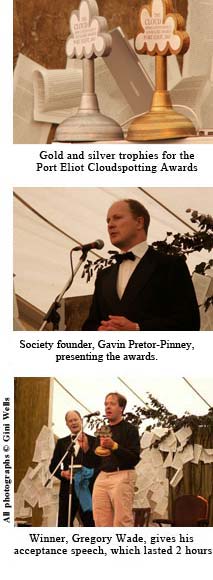
At the end of July, the Cloud Appreciation Society put on a free exhibition of a selection of the photographs from our new book ‘A Pig with Six Legs and other clouds from The Cloud Appreciation Society’ at the Port Eliot Literary Festival in Cornwall, UK.
During the festival we set a competition for festival goers to take photographs of clouds in the shape of things during the weekend. The results were judged and awarded prizes at a star-studded, Oscars-like ceremony at the end of the weekend. Society founder, Gavin Pretor-Pinney, presented the gold and silver cloudspotting award trophies (see right). Luckily the recipients didn’t realize until they had returned to their seats that these were in fact made out of rubber toilet plungers, sprayed with sparkly paint.
Winner: ‘Laughing Man‘ by Gregory Wade.
Runner-up: ‘Duck of the Devil‘ by Bianca Daniels.
Click on the thumbnails below to see them full size.






